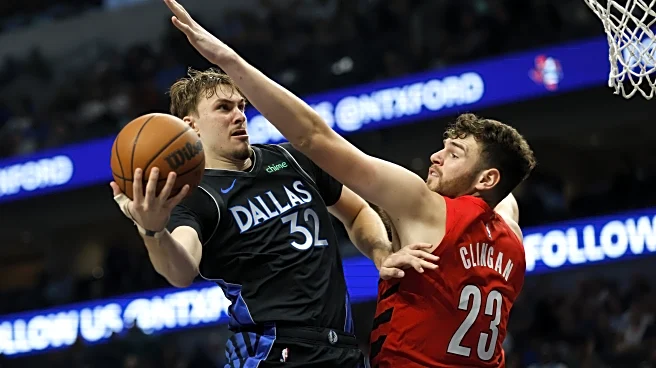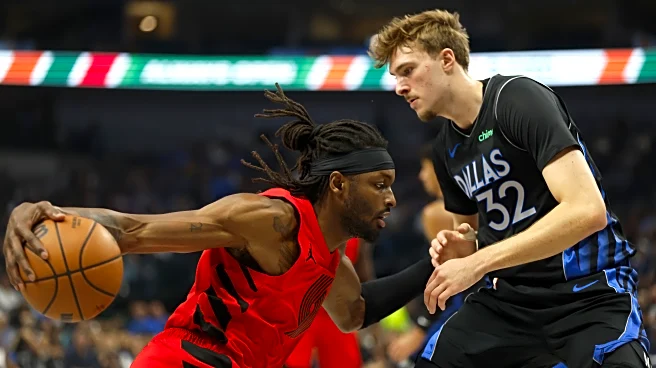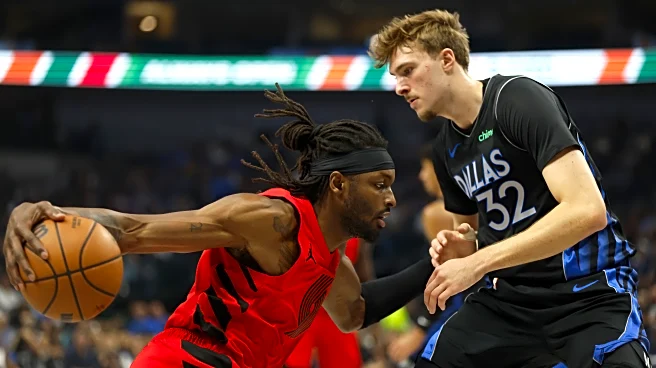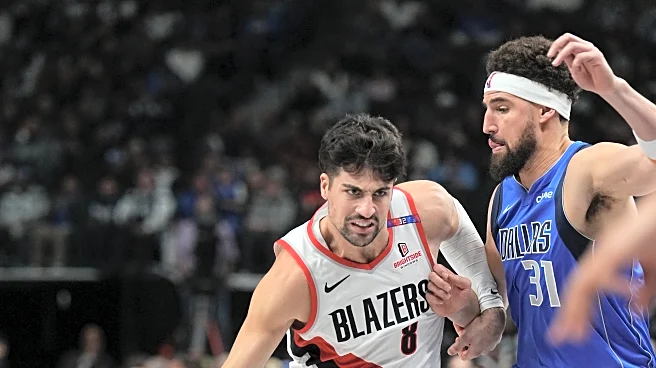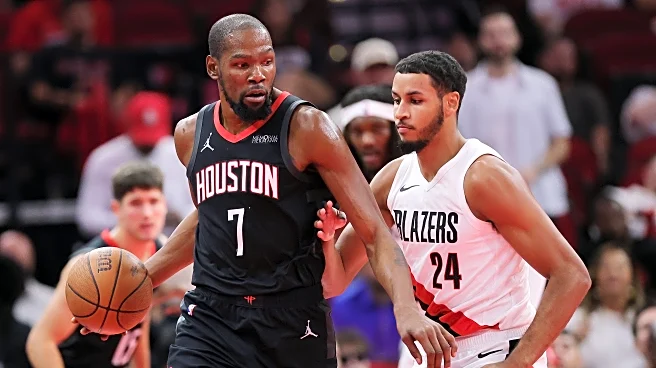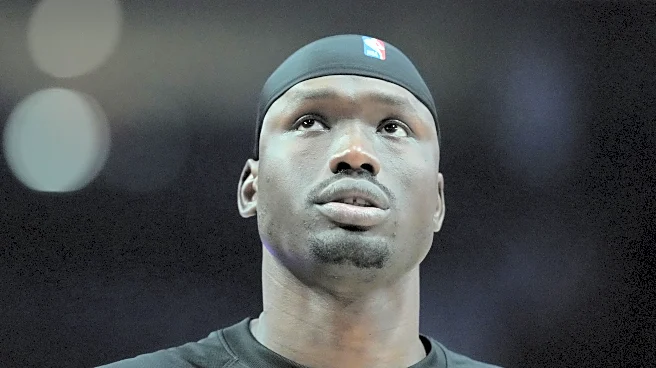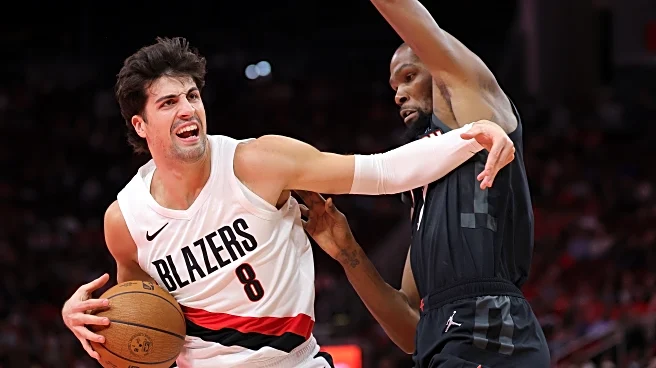The Portland Trail Blazers are in the midst of a 1-4 slide, having lost 5 of their last 7 games following a hot start to the 2025-26 regular season. As the record has slipped, many Portland fans have pointed
to the same culprit: defense. Over their last five outings the Blazers have given up over 129 points per game to opponents. That’s well above their season average of 122.
Granted, an overtime game versus the Dallas Mavericks fouls the sample a bit, but even compensating for that result, the Blazers have given up between 125-127 points per game over the last week and a half after holding opponents to 118 in the three weeks prior. That’s not great.
Formally in the Blazer’s Edge Mailbag and informally in comments across the site, readers have asked what’s going on with Portland’s defense. We’re going to dissect the issue today.
The most interesting thing about this slippage is that it doesn’t come from any of the sources you’d expect.
- Right now the Blazers rank 26th in the NBA, allowing opponents 48.9% in overall field goal shooting percentage. On November 1st, before the losing began, they allowed 48.6%, a virtually identical number.
- The same holds true for three-point percentage allowed. Opponents are shooting 35.8% versus Portland now, giving them the 15th-best percentage defense in the league in that category. Before the streak they allowed 36.0%, 14th-best.
- Anecdotally, I suspected the Blazers of tiring in transition, allowing the opponent more fast break points. The opposite is true. They’re averaging 16.7 fast break points per game right now. They allowed 17.8 before they started losing.
- A few people have been wondering whether the referees have been jobbing out the Blazers, again based on anecdotal incidents we can easily recall. If so, it hasn’t been showing in the aggregate stats. Portland has allowed opponents 29.4 free throw attempts on average this season. That number was 30.7 back on November 1st. Granted, both results are Bottom-5 in the NBA, but we can’t claim that the situation has gotten worse now than it was when the Blazers were winning.
The book on Portland is this: their defense isn’t great, but it’s never been great. It’s not like they were locking down opponents earlier in the year and they’ve stopped. They continue to be vaguely permissive on the defensive end. It’s simply leading to losses now when it led to wins–or at least .500 ball–earlier.
That’s not the whole story, though. Underneath the hood, things have changed. They’re just not in the engine block of the defense. It’s as rumbly, and occasionally powerful, as ever. To understand why Portland isn’t defending as well, we need to look at the transmission.
The huge red-flag number is this: On November 1st, before they started losing, the Blazers led the league with 82.2 field goal attempts per game allowed to opponents. Today they rank 13th, averaging 88.1 allowed. That’s an extra half-dozen shots ceded to the other team. Combined with near-50% shooting allowed, it averages to 6-ish points per game spotted to the enemy. Given the relatively narrow margins under which the Blazers try to thrive, that’s an enormous number.
The sources of this decline come exactly where you’d expect. On November 1st, the Blazers led the league, getting steals on an incredible 10% of opposing plays. Now they’re 10th at 7.9%. In like manner, the Blazers forced turnovers on 20% of opposing possessions before November hit, outpacing their competition by a mile. They’re still 6th in the NBA, but the percentage has shrunk to 15.9%.
Portland’s still good in these categories, but they weren’t winning by being good. They were flat-out great. As soon as those extra possessions went away, though, so did the Blazers’ ability to win.
We can dig a little deeper too.
Via observation alone, I suspected the three-point arc to be part of Portland’s problem. It’s not. They’re near the top of the league in preventing three-point shots from going up and (as we said) right in the middle in three-point percentage defense. That’s just as true now as it was two weeks ago.
You know where Portland’s defense has slipped? Inside. They currently average 52.2 points in the paint allowed. At the start of November, that number was 46.7. That’s a 5.5-point difference.
The Blazers also rank 10th in assists per possession defense, allowing opponents assists on 24.7% of plays. Before they started losing, they were 4th at 21.9%.
The best guess here is that Portland is maintaining their egg-shell defense at the arc by closing out on threes, concentrating on early dribbles against drivers. But once that shell gets broken, they don’t have enough recovery ability inside to prevent the score. They made up for it early in the season by forcing turnovers off of that aggressive initial point-of-attack defense, patrolling the passing lanes as well. Once those turnovers went away, the lack of basic interior defense and rotation integrity got exposed.
Here’s another interesting stat, not strictly about defense but a by-product of it. At our early-season reference point the Blazers were scoring 19.7 fast break points per game. Today they’re averaging 16.9. Those 2.8 points are significant in themselves, but more so when you consider that recent performances are dragging down that average. In other words, it’s not like Portland is scoring 16.9 fast break points per game right now. They’ve scored enough below that to pull down the overall average to that number after their lofty start.
We said above that Portland’s actual fast break point defense has improved slightly as the season has progressed. But when you combine the offensive and defensive fast break data, you’ll find that the Blazers were generating a +1.9 point margin per game up until November. That number has dwindled to just +0.2, a virtual tie, now.
Over several game recaps, we’ve noted that Portland has appeared to pick up intensity on the offensive glass over recent weeks. Rebounding statistics confirm that. The sample size and difference are too small to draw a conclusion right now, but current trends indicate that the Blazers are generating more offensive rebounds per possession and giving up more to the opponent at the same time, and the giving up is just as strong as the gain, thus nullifying another potential advantage for a team that needs all of them in order to succeed.
Long story short, here’s the book on what’s happening to Portland right now:
- The Blazers were already winning by small margins. That beats the losing by huge margins they’ve done in past seasons, but the good feeling of winning obscures a little how precarious those victories have been. When every game is a coin flip, sometimes you’re going to get a run of tails.
- Portland has not been generating wins by bedrock, percentage means, especially on defense. They’re somewhere between good and mediocre in three-point defense, bad at committing fouls, not great in overall percentage defense. In boxing terms, they’re not exactly a ripped heavyweight. More like a doughy middleweight.
- Sheer number of punches thrown (and opponent punches dodged) provide the simplest explanation for the Blazers winning despite the lack of physique and skill. They generate those extra punches through turnovers primarily, also through offensive rebounds. Those allow easy buckets–either on the run or on put-backs–that give Portland the requisite edge.
- Once the advantages in turnovers forced and offensive rebounds gained started to disappear–either because the Blazers didn’t generate them or opponents generated just as much–games became a punch-vs-punch affair. This has been true even though pace has remained fairly brisk. When a 12-shot-per-game advantage for Portland slips down to 6, the Blazers don’t have enough organic defense or offense to compensate.
The big question, of course, is how to change this. It’d be easier if we could point to a player or a particular scheme and say, “Switch this out and they’re good!” Right now it looks like Portland operates more on a zero-sum sliding scale. They can emphasize more aggression at the point of attack and sell out for those crucial turnovers they need, but realistically even at their phenomenal rates, they were only forcing them 1 possession in 5 and barely winning at that clip. The issue is, does expending that extra energy–committing to the reach and/or interception–leave them less able to cover in the basic, percentage sense? If so, they’re going to suffer in the long run even if they do go through runs of amazing-looking opportunistic defense.
It’s easy to look at Toumani Camara, for instance, and say that his defense isn’t quite to the level it was last season and he needs to step up. Ok, but step up doing what? If he’s used at the point of attack and instructed to generate as many turnovers as possible no matter the cost, he can probably do that well. But then we can’t blame him when a dribbler gets by him because he went for the steal, nor fault him for not sliding over in the lane to draw the help-defense charges we admired so much last season. If we want him to do those things, the Blazers have to take him off of the point of attack and/or instruct him to be a little more conservative when manning that initial post.
We can say similar things for Deni Avdija in a different way. Do we want him on the floor, scrambling for every loose ball, expending 100% of his energy on each defensive play? If so, don’t be surprised if his three-pointer starts hitting the front rim late in games from fatigue. We could solve that by subbing out Deni, but then who scores for the Blazers? Can Avdija’s substitute generate as much speed and turnover potential as he?
In the end, this boils down to a talent/depth/skill issue more than a scheme or player correction one. Getting mid-rotation players like Matisse Thybulle and Scoot Henderson back should help from an energy perspective. Playing untried players like Caleb Love, Sidi Cissoko, and Rayan Rupert hasn’t helped the offensive margin or defensive integrity. But even that might be a band-aid on a bleeding wound more than a cure until the Blazers get, or develop, more help.
Ultimately Portland will have to figure out how to cut back on easy points allowed inside while still defending well at the arc and grabbing defensive rebounds to end opposing possessions. That’s the basic idea of defense. Robbing Peter to pay Paul by playing smaller lineups that can’t stop opponents inside, bigger lineups that can’t rotate out to the perimeter, or young, energy-based lineups that can’t score or defend without fouling won’t solve the issue.
Right now Portland is like a sputtering bullet train, capable of going fast but still working out the engineering and maintenance on the approach. They’re likely to figure it out as the season goes onward. The bigger question is, are they on the right track? The jury’s still out on that one. Getting the vehicle running smoothly isn’t helpful unless it also brings you to a productive destination. Let’s hope that’s not the epitaph on Portland’s year and their new approach.
